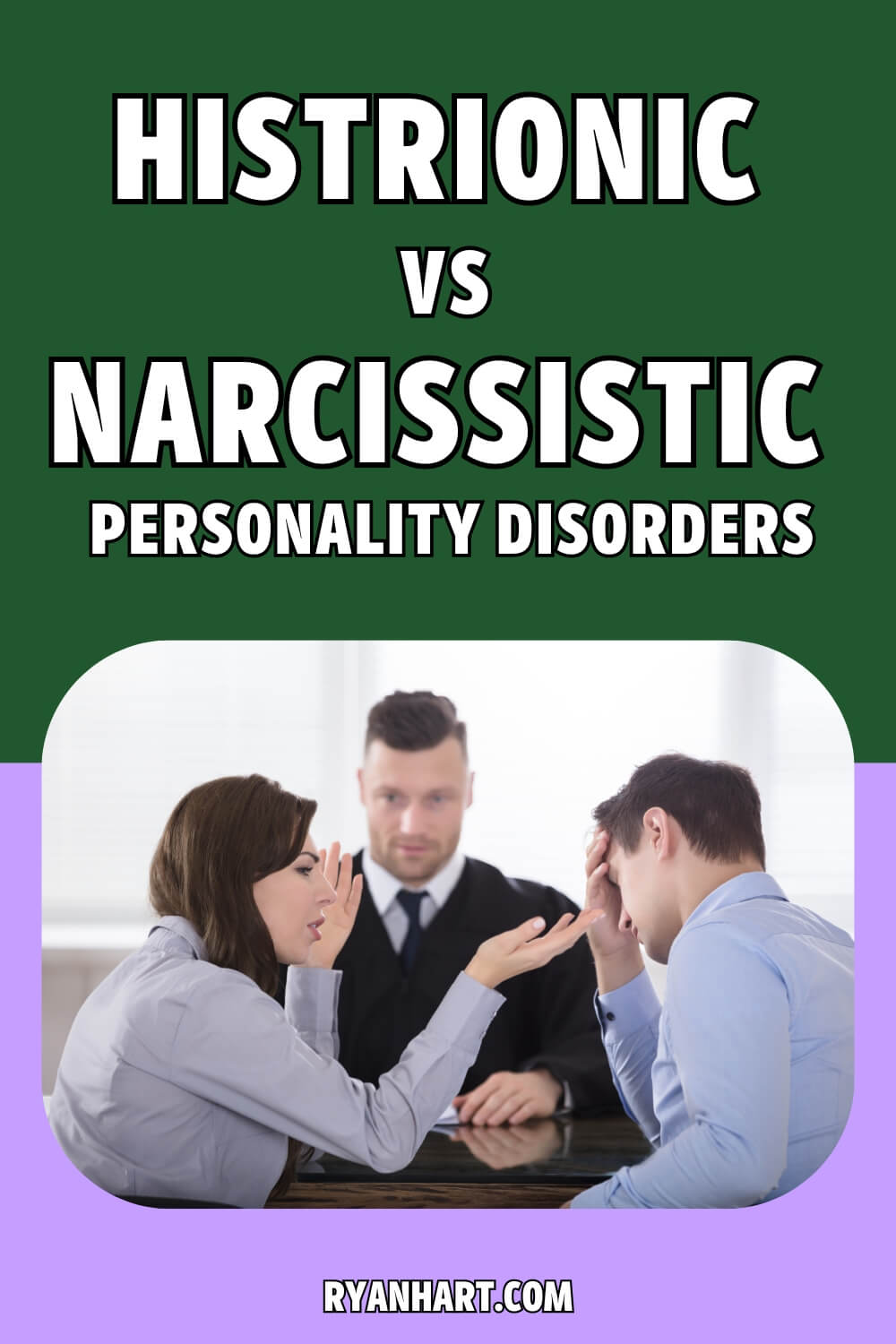Histrionic vs Narcissistic Personality Disorders
by Ryan Hart | Updated on April 6, 2024 | Post may contain affiliate links. As an Amazon Associate we earn from qualifying purchases.
Are you curious about the differences between Histrionic Personality Disorder (HPD) and Narcissistic Personality Disorder (NPD)?
While these two personality disorders may share some similarities, they are distinct conditions that require different treatment approaches. Understanding the key differences between HPD and NPD can help you or a loved one receive the appropriate care and support.
HPD is characterized by a pattern of excessive emotionality, attention-seeking behavior, and dramatic behavior. People with HPD may feel uncomfortable when they are not the center of attention and may go to great lengths to get noticed.
In contrast, NPD is characterized by a grandiose sense of self-importance, a lack of empathy for others, and a need for admiration. People with NPD may have a distorted sense of their own abilities and accomplishments and may feel entitled to special treatment.

What are Personality Disorders?
Personality disorders are mental health conditions that affect the way you think, feel, and behave. They are long-term patterns of behavior that are inflexible and pervasive across a range of personal and social situations.
People with personality disorders frequently struggle with relationships, work, and daily activities because their behavior is unpredictable, dramatic, or overly emotional. Personality disorders are classified into three clusters:
- Cluster A: defined by odd or eccentric behavior
- Cluster B: characterized by dramatic, overly emotional, or unpredictable behavior
- Cluster C: characterized by anxious or fearful behavior
Histrionic personality disorder (HPD) and narcissistic personality disorder (NPD) are both cluster B personality disorders. They share some similarities, but they are also distinct in their symptoms and behavior patterns.
HPD is characterized by a pattern of excessive emotionality and attention-seeking behavior. People with HPD often feel uncomfortable when they are not the center of attention and may use their physical appearance or sexuality to draw attention to themselves. They may also be overly dramatic, flirtatious, or seductive in their behavior.
NPD, on the other hand, is characterized by a grandiose sense of self-importance, a lack of empathy, and a need for admiration. People with NPD often believe that they are superior to others and may exploit or manipulate others to get what they want. They may also have a sense of entitlement and may become angry or hostile when they do not receive the admiration or attention they believe they deserve.
It is important to note that personality disorders are not the same as normal personality traits. Everyone has unique personality traits that make them who they are, but personality disorders are extreme and maladaptive versions of those traits that cause significant distress and impairment in daily life.
If you suspect that you or someone you know may have a personality disorder, it is important to seek professional help. Treatment options can be recommended by a mental health professional based on an accurate diagnosis.
Histrionic Personality Disorder
If you have Histrionic Personality Disorder (HPD), you may be described as someone who thrives on attention and has excessive emotionality. You might also be known for self-dramatization, theatricality, and sexually seductive behavior. You enjoy being the center of attention and may try to be the life of the party.
Characteristics of Histrionic Personality
People with HPD are often described as attention-seeking and may go to great lengths to get it. They may dress provocatively or exaggerate their emotions to get noticed. They may also be easily influenced by others and may change their opinions or behavior to fit in with a certain group.
Diagnosis and Prevalence of Histrionic Personality Disorder
HPD is diagnosed by a mental health professional based on diagnostic criteria outlined in the DSM-5. The prevalence of HPD is estimated to be around 1-2% of the general population. It is more common in women than in men.
Treatment for Histrionic Personality Disorder
Psychotherapy, or talk therapy, is the most common treatment for HPD. Psychodynamic psychotherapy and group therapy may be effective in helping people with HPD learn to manage their emotions and behavior. Medication may also be prescribed to treat symptoms such as anxiety or depression.
Histrionic Personality Disorder in Relationships
People with HPD may struggle to form stable relationships due to their attention-seeking behavior and excessive emotionality. They may also struggle to maintain healthy boundaries in relationships and may become overly dependent on their partners. Family members of people with HPD may also struggle to understand their behavior and may need support in coping with their loved one’s diagnosis.
Narcissistic Personality Disorder
Suppose you or someone you know has been diagnosed with Narcissistic Personality Disorder (NPD). In that case, it is important to understand the characteristics of this condition, the diagnosis and prevalence, and the available treatments. NPD is a type of personality disorder that affects the way a person thinks, feels, and behaves.
Characteristics of Narcissistic Personality
People with NPD often have a sense of entitlement and grandiosity. They may have an inflated sense of self-worth and believe that they are superior to others. They may also lack empathy and have difficulty understanding or caring about other people’s feelings.
Individuals with NPD may be charming and charismatic, but they may also be manipulative and use others to get what they want. They may seek admiration and attention from others and become angry or defensive when they don’t receive it.
Diagnosis and Prevalence of Narcissistic Personality Disorder
NPD is diagnosed by a mental health professional using specific diagnostic criteria outlined in the Diagnostic and Statistical Manual of Mental Disorders (DSM-5). The prevalence of NPD is estimated to be around 6.2% of the general population.
Treatment for Narcissistic Personality Disorder
Psychotherapy is the primary treatment for NPD. Mentalization-based therapy and supportive psychotherapy have been shown to be effective in treating this condition. Family therapy may also be helpful in improving relationships and communication within the family.
It is important to note that individuals with NPD may be resistant to treatment and may not see their behavior as problematic.
Narcissistic Personality Disorder in Relationships
People with NPD may struggle to maintain stable relationships due to their lack of empathy and sense of entitlement. They may also struggle with intimacy and may view others as objects to be used for their own gratification.
Family members of individuals with NPD may also experience difficulties in their relationships with them. It is important for family members to seek support and therapy to help them cope with the challenges of having a loved one with NPD.
Overall, NPD can be a challenging condition to manage and treat. It is important to seek the help of a mental health professional if you or someone you know is struggling with this condition.
What’s the Difference Between Histrionic and Narcissistic Personality Disorders?
When it comes to personality disorders, Histrionic Personality Disorder (HPD) and Narcissistic Personality Disorder (NPD) are two conditions that are often compared. Both HPD and NPD are classified as Cluster B personality disorders, which are characterized by dramatic, emotional, and erratic behavior. However, there are some key differences between the two disorders.
One of the main differences between HPD and NPD is their focus on attention. People with HPD have an intense desire to be the center of attention and will go to great lengths to achieve it. They may dress provocatively, flirt excessively, or use dramatic gestures to get noticed. On the other hand, people with NPD are more focused on admiration and approval.
They believe they are superior to others and expect to be treated as such. They may demand special treatment or become angry when they are not given the attention they believe they deserve.
Another difference between the two disorders is their emotional expression. People with HPD tend to be overly emotional and may have difficulty controlling their feelings.
They may become easily upset or offended and may throw tantrums or make a scene to get attention. People with NPD, on the other hand, may appear emotionally detached or unemotional. They may have difficulty empathizing with others and may appear cold or aloof.
In terms of traits, people with HPD tend to be more impulsive and may act on their emotions without thinking. They may also be more suggestible and easily influenced by others. People with NPD, on the other hand, tend to be more rigid in their thinking and behavior. They may have a strong need for control and may become angry or defensive when their authority is challenged.

Frequently Asked Questions
What are the key differences between histrionic and narcissistic personality disorders?
Histrionic personality disorder (HPD) and narcissistic personality disorder (NPD) are both cluster B personality disorders, but they have some differences. People with HPD tend to be more emotional and dramatic, while those with NPD tend to have an inflated sense of self-importance and lack empathy for others.
Individuals with HPD often seek attention and approval from others, while those with NPD may feel entitled to admiration and special treatment.
How can someone distinguish between histrionic and narcissistic traits in a person?
It can be challenging to distinguish between histrionic and narcissistic traits in a person, as they may overlap. However, some key differences can help. People with histrionic traits tend to be more emotional and dramatic, while those with narcissistic traits may have an inflated sense of self-importance and lack empathy for others. Individuals with histrionic traits often seek attention and approval from others, while those with narcissistic traits may feel entitled to admiration and special treatment.
What is the relationship between narcissistic and histrionic personality disorders?
Narcissistic and histrionic personality disorders share some similarities, as they are both cluster B personality disorders. However, they also have some differences. People with HPD tend to be more emotional and dramatic, while those with NPD tend to have an inflated sense of self-importance and lack empathy for others. Individuals with HPD often seek attention and approval from others, while those with NPD may feel entitled to admiration and special treatment.
What are some common traits of histrionic and narcissistic personality disorders?
People with histrionic and narcissistic personality disorders may share some common traits, such as a desire for attention and admiration, a tendency to be manipulative or controlling, and a lack of empathy for others. Individuals with histrionic personality disorder may also be more emotional and dramatic, while those with narcissistic personality disorder may have an inflated sense of self-importance and entitlement.
Can a person have both histrionic and narcissistic traits?
Yes, it is possible for a person to have both histrionic and narcissistic traits. However, a trained mental health professional would need to make a diagnosis of histrionic personality disorder, narcissistic personality disorder, or both.
What are some other personality disorders that share similarities with narcissism and histrionic personality disorders?
Other personality disorders that share some similarities with narcissism and histrionic personality disorders include borderline personality disorder, antisocial personality disorder, and dependent personality disorder. However, each of these disorders has distinct symptoms and diagnostic criteria, and a trained mental health professional would need to make a diagnosis.
Related: